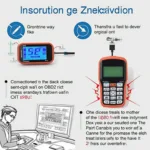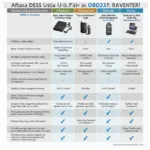OBD2 relative throttle position is a crucial parameter monitored by your vehicle’s onboard diagnostic system. It represents the percentage of the throttle opening, providing valuable insights into engine performance and potential issues. This article delves into the intricacies of OBD2 relative throttle position, explaining its significance, common problems, and diagnostic techniques. We’ll explore how this data point can help you maintain optimal vehicle health and performance.
Understanding the OBD2 relative throttle position is essential for anyone who wants to keep their car running smoothly. It’s a key indicator of how your engine is breathing, and can help you diagnose a variety of problems. What exactly is it? The relative throttle position sensor (TPS) measures the opening angle of the throttle plate. This measurement is then converted into a percentage, which is transmitted to the engine control unit (ECU). The ECU uses this information to calculate the correct amount of fuel to inject and the optimal ignition timing. A faulty TPS can lead to a range of driveability issues, including poor acceleration, rough idling, and decreased fuel economy.
What Does OBD2 Relative Throttle Position Tell You?
The OBD2 relative throttle position provides valuable data about how much air is entering the engine. A higher percentage indicates a wider throttle opening, allowing more air into the engine for increased power. Conversely, a lower percentage signifies a smaller opening, restricting airflow for idling or cruising. Monitoring this parameter can help identify issues such as a sticking throttle, a faulty TPS, or problems with the throttle body itself. Learning more about obd2 throttle position can provide a broader understanding of this crucial system.
How is OBD2 Relative Throttle Position Measured?
The OBD2 relative throttle position is measured by the TPS, usually located on the throttle body. This sensor uses a potentiometer to detect the angle of the throttle plate. As the throttle plate rotates, the potentiometer’s resistance changes, providing a corresponding voltage signal to the ECU. The ECU interprets this voltage as a percentage of throttle opening.
Common Problems Related to OBD2 Relative Throttle Position
Several issues can arise with the OBD2 relative throttle position system. A common problem is a faulty TPS, which can send inaccurate readings to the ECU, leading to performance problems. A sticking throttle cable or a dirty throttle body can also affect the throttle position and cause similar symptoms. A comprehensive understanding of mod 21 27 obd2 can further enhance your knowledge of diagnostic procedures.
How to Diagnose OBD2 Relative Throttle Position Issues
Diagnosing OBD2 relative throttle position problems typically involves using an OBD2 scanner to read the live data stream from the TPS. You can observe the percentage reading while operating the throttle to check for inconsistencies or erratic behavior. A multimeter can also be used to test the TPS directly for proper voltage output.
“A smooth, consistent change in the relative throttle position reading is crucial for optimal engine performance,” says automotive expert John Miller, ASE Certified Master Technician. “Any sudden jumps or drops in the reading can indicate a problem with the TPS or related components.”
What is the difference between absolute and relative throttle position?
While relative throttle position measures the percentage of throttle opening, absolute throttle position represents the actual angle of the throttle plate. This distinction is important for precise control of engine performance.
“Knowing the difference between absolute and relative throttle position is important for accurate diagnosis,” adds Miller. “Understanding how these measurements interact allows mechanics to pinpoint the root cause of performance issues.” It’s worth noting that some vehicles might experience specific issues, such as those outlined in s430 obd2 code p112009, which highlight the importance of accurate diagnostics.
Conclusion
The OBD2 relative throttle position is a vital parameter for understanding engine performance and diagnosing potential issues. By monitoring this data, you can identify problems early and maintain optimal vehicle health. Regular checks with an OBD2 scanner and understanding the underlying principles can help keep your car running smoothly. Remember that a properly functioning throttle position system is crucial for fuel efficiency and overall engine performance. Keeping your vehicle in top shape also includes understanding its engine load, which you can explore further in our article on obd2 engine load. For those considering performance enhancements, understanding the implications of modifications like the nitro obd2 chip 2004 silverado is also essential.
FAQ
- What is a normal OBD2 relative throttle position at idle?
- What causes a high OBD2 relative throttle position at idle?
- Can a bad TPS cause a check engine light?
- How do I test a TPS with a multimeter?
- What are the symptoms of a bad throttle position sensor?
- How much does it cost to replace a TPS?
- Can I clean a throttle position sensor?
Need further assistance? Please contact us via WhatsApp: +1(641)206-8880, Email: [email protected] or visit us at 789 Elm Street, San Francisco, CA 94102, USA. Our customer service team is available 24/7.

